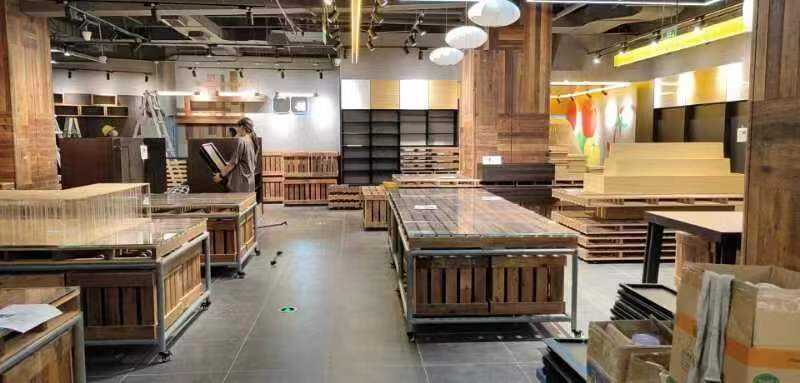איך לתכנן תערוכת קצה שמשכה תשומת לב?
בעולם הקמעונאות, משיכת תשומת הלב של הלקוחות היא קריטית להגברת המכירות ויצירת חוויות קניות זכורות. אחת האסטרטגיות האפקטיביות ביותר בתצוגת סחורות היא השימוש בתערוכות בקצה המעברים. הממוקמות בקצות המעברים, תאי התערוכה הללו תופסים שטח מכרה מובחר שבו הקונים נוטים להאט או להפנות, מה שהופך אותם ליעילים במיוחד לתצוגה של מוצרים תזונתיים, עונתיים או חדשים. תערוכת קצה שמשכה תשומת לב לא רק מגבירה את הנראות של המוצרים אלא גם מחזקת את זהות המותג ומעוררת רצון לרכישה אימפולסיבית.
עיצוב אנדקפס אפקטיביים דורש יותר מרק שילוב של מוצרים בצורה מסודרת. הוא משלב יצירתיות, פסיכולוגיה של הצרכן, מיקום אסטרטגי ועיצוב ויזואלי. 글 זה בוחן את האלמנטים והטכניקות המרכזיים ליצירת מוצג סוף מדף , השגיאות להימנע מהן, וכיצד מגמות חדשות משפיעות על עתיד תצוגות הקמעונאות.
המטרה של תצוגת אנדקפ
הפונקציה העיקרית של מוצג סוף מדף היא למקסם חשיפה למוצרים. בניגוד למיקום רגיל שעל מדפים מתחרים בו מותגים רבים, אנדקפ מציע אזור ייחודי כדי להבליט מוצרים נבחרים. מטרתו היא להציג פריטים חדשים, לקדם הצעות מיוחדות, לחזק מסcampaignים שיווקיים ולעודד קניות אימפולסיביות. בשל הנראות הגבוהה שלהם, תצוגות אנדקפ יוצרות לעיתים קרובות מכירות גבוהות בהרבה מהמדפים הרגילים.
אלמנטים מרכזיים של תצוגת אנדקפ מושכת
אסתטיקה חזותית
הרושם הראשוני הוא החשוב ביותר. צבעים, דוגמאות ואביזרים צריכים לעבוד יחד כדי לגרום לתצוגה להתבלט מהמעברים הסובבים אותה. ניגודים בולטים מושכים תשומת לב, בעוד קווים נקיים וסימטריה מבטיחים שהתצוגה לא תהיה מכריעה. תאורה משחקת תפקיד חשוב לא פחות על ידי שיפור הצבעים ומשיכת תשומת הלב לפריטים המוצגים.
מיקום מוצרים אסטרטגי
המיקום של המוצרים בתוך התצוגה הוא קריטי. פריטים בגובה העיניים נוטים למשוך יותר תשומת לב ולקנות, לכן מוצרי מכר שיא, פריטים קידומיים או מוצרים עם רווח גבוה צריכים למלא את המרחב הזה. מוצרים תומכים או משלימים יכולים להיות מוצבים מעל או מתחת, ומעוררי קונים לחקור את כל התצוגה.
עקביות בסימן מסחרי
תצוגת קצה מושכת-עין צריכה להציג בבהירות את זהות המותג. שימוש עקבי בסמלים, צבעים וסלוגנים מבטיחים שrokhes יזהו את המותג מיד. זיהוי מותג חזק בונה ביטחון ויצירת מראה מקצועי שמייחד את התצוגה מהממתחרים.

מסר ברור
לרוב הקונים אין אלא מספר שניות כדי לקלוט את התצוגה. המסר חייב להיות פשוט ומשפיע. גופנים גדולים וברורים עם פסוקים קצרים כמו "מוצר חדש", "הצעה מיוחדת" או "לזמן מוגבל בלבד" מצלינים את הערך במהירות. שלטים עמוסים מבלבלים את הקונים, בעוד מסר ברור מעלה את אחוזי ההמרה.
גישה וvenience
התצוגות אמורות להיבנות בהתאם לחווית הקנייה של הקונה. מוצרים חייב להיות קל להגיע אל הפריטים ולתפעל בהם, והמחירים חייבים להיות נראים בבהירות. תצוגות שאינן נגישות מדאיגות את המשתמש, בעוד תצוגות שידידותיות למשתמש יוצרות מסלול חלק למכירה.
שיטות לתכנון תצוגה זכרונית
סיפור תימטי
שימוש בערכת נושא הוא אחת הדרכים החזקות ביותר ליצירת קשר עם לקוחות. אירועים עונתיים כמו חגיגות, חזרה לבית ספר או חופשות קיץ מציעים הזדמנויות לערכות תערוכת נושא שמרשימות רגשית. סיפוריות עולה על רמת הדקורציה, ומציגה איך המוצר משתלב בחיים של הלקוח או פותר צורך מסוים.
שיווק צולב
הצגת מוצרים קשורים בערכה אחת מגדילה את הנוחות ומעוררת את המכירות. לדוגמה, פסטה המוצגת לצד רוטב וגבינה מציעה לקונים פתרון ארוחה שלמה. שיווק צולב אינו רק מוסיף ערך אלא גם מעורר קנייה בכמויות גדולות יותר.
תאורה
תאורה יכולה להפוך תערוכת רגילה לערכה מושכת-עין. תאורי אור מיקוד, רכיבי LED דקורטיביים או שלטים מאירים מאחור מדגישים את המוצרים המרכזיים וсоздים אווירה מפתה. תערוכות מוארות כראוי מושכות תשומת לב גם בסביבות קמעונאות עסוקות.
תכונות אינטראקטיביות
אלמנטים אינטראקטיביים מעוררים את הלקוחות ברמה עמוקה יותר. מסכים מגע, קודים ל QR המובילים למתכונים או למידע על המוצר, והצגות חיות של המוצר מעודדות קונים להישאר מול הדיסプレー ולפתח עניין גדול יותר. ככל שיתמידו יותר, כך יקנו יותר.
דחפור באמצעות קידום מכירות
יצירת תחושת דחפור מעוררת פעולה. קצה מדפים שמפרסמים מבצעים לזמן מוגבל, הצעות ייחודיות או מבצעים עונתיים, מושכים את תשומת הלב של הקונים ומעודדים החלטות מהירות. שילוב של תחושת דחפור עם שלטים בולטים הופך את ההצעה למושכת ולחמורה מבחינה זמנית.
טעויות נפוצות שיש להימנע מהן
תצוגת קצה שמרשיטה את תשומת הלב עשויה לאבד את יעילותה אם היא מוצעת בצורה גרועה. הצפנת התצוגה במוצרים רבים מדי יוצרת בלבול بصרי ומבילה לבלבול אצל הלקוחות. השמטת זיהוי המותג גורמת למראה כללי שאינו משפיע. שלטים לא מובנים או מחירים מוסתרים מעוררים את זעם הלקוחות ופוגעים באמון. תצוגות ישנות שאינן מותקנות בקביעות אינן תופסות את תשומת הלב לאורך זמן. קשי נגישות, כגון מוצרי תצוגה שמרומים או שפוחים מדי, מעודרים את האינטראקציה.
התפקיד של נתונים בעיצוב תצוגות קצה
תובנות המבוססות על נתונים הופכות את התצוגות להשפעה רבה יותר. נתוני מכירות מגלים אילו מוצרים מצליחים ביותר בתצוגות קצה, בעוד ניתוח תנועה מזוהה אזורים עם נראות גבוהה. טכנולוגיות כמו מיפוי חום מציגות כיצד הלקוחות מתבוננים בתצוגות, ונותנות תובנות על מיקום המוצרים ויעילות הסידור. באמצעות שילוב של יצירתיות ואנליזה, קונים יכולים לעצב תצוגות קצה שמרשיטות את תשומת הלב ומביאות תוצאות עקביות.
קיימות בתצוגות קצה
קיימות הופכת להיות חשובה יותר הן ללקוחות והן למותגים. עיצוב של תצוגות בקצה המעברים בחומרים ידידותיים לסביבה, רכיבים שניתנים להחזרה ובמבנה מודולרי מפחית את ההשפעה הסביבתית. הדגשת תכונות הקיימות של המוצרים המוצגים תורמת לשיקום הלקוח. תצוגות המודעות לסביבה מושכות לא רק את הקונים אלא גם תורמות ליוזמות של אחריות חברתית של הארגון.
מקרי דוגמה של תצוגות בקצה המעברים מוצלחות
דוגמאות מחברות קמעונאות גלובליות מציגות את היצירתיות של תצוגות בקצה המעברים. שרשראות מזון יוצרות תצוגות המבוססות על מנות על ידי קיבוץ רכיבים יחדיו. חנויות אלקטרוניקה משתמשות בקצות מעברים עם עיצוב מודרני ומותגי, מציגים דוגמאות חיות כדי לשקול מוצרים חדשים. חברות משקאות יוצרות תצוגות ערב ומעניינות לפי העונה, כמו חבילות קיץ או חבילות לחגים, המשדרות עם אורח החיים של הקונים. הדוגמאות הללו מדגימות איך עיצוב מחויב תורם ישירות להגדלת מכירות ולחיזוק ההשתתפות של המותג.
Тенденציות עתידיות בעיצוב תצוגות בקצה המעברים
העתיד של תצוגות בולטות ישלב טכנולוגיה דיגיטלית ואישור אישי. שלטים דיגיטליים דינמיים יוכלו להתאים את ההנחות לפי זמן היום או הדמוגרפיה של הקונים. חוויות מציאות רבודה עשויות לאפשר לקונים לראות מוצרים בمنازלם או לגשת מייד למידע מפורט. אינטליגנציה מלאכותית עשויה אפילו להכווין קונים לכיוון תצוגות המתאימות לדפוסי הקנייה שלהם. במקביל, עמידות תישאר מרכזית, עם מבני תצוגה לשימוש חוזר וחומרים ניתנים لإعادة צורן שיתקבלו כסטנדרט.
סיכום
תצוגה מושכת את העין היא אחד הכלים החשובים ביותר להגברת המכירות ובניית מודעות למותג בחללי קמעונאיים. יכולתה למשוך תשומת לב, להבליט מבצעים ולהשפיע על התנהגות הקנייה הופכת אותה לחיונית עבור קמעונאים ומותגים כאחד. על ידי התמקדות במושך חזותי, מיקום מוצרים אסטרטגי, מיתוג עקבי, מסרים ברורים ונוחות לקונים, עסקים יכולים לעצב תצוגות שיבלטו בחנויות צפופות.
שילוב סיפור, תצוגה משותפת, תאורה, אינטראקטיביות וקיימות מעצימים את האפקטיביות. הימנעות משגיאות נפוצות ויישום תובנות המבוססות על נתונים מבטיחים שהתצוגות ישארו חדשות, מעוררות עניין ורנטביליות. ככל שחדשנות דיגיטלית ועיצוב שמר על הסביבה הופכים להיות חשובים יותר, תצוגות סיום מדפסות (Endcap Displays) ימשיכו להשתנות ויציירו את פני שיווק קמעונאי בעתיד.
שאלות נפוצות
מה גורם לתצוגת סיום מדפסת להיות אפקטיבית?
תצוגה אפקטיבית מושכת תשומת לב באמצעות מראה מושך, מיקום אסטרטגי של המוצרים והעברת מסרים ברורים, תוך שמירה על עקביות המותג.
באיזו תדירות יש לעדכן תצוגות סיום מדפסת?
התצוגות צריכות להorefreshadas, לדוגמה אחת לכמה שבועות, כדי לשמור על עניין הקונים ולהתאים לקמפיינים עונתיים.
האם תצוגות סיום מדפסת יכולות לקדם מספר מוצרים?
כן, סיום מדפסות מצליחות לעיתים קרובות כאשר הן מציגות מוצרים משלימים יחד, יוצרות נוחות ומעוררות מכירות.
האם תכונות אינטראקטיביות משפרות את תצוגות סיום המדפסת?
כן, אלמנטים כגון מסכים מגע, קודים דו-ממדיים וعروض חייות מעוררים מעורבות של לקוחות מעמיקה ואינטראקציה ממושכת יותר.
האם תאי תצוגה יכולים להיות ברת-תוקף?
בהחלט. שימוש בחומרים ניתנים لإعادة מחזור, מבנים מודולריים ומודעות אקולוגית הופכים את תאי התצוגה להשפעה וידידותית לסביבה.
תוכן העניינים
- איך לתכנן תערוכת קצה שמשכה תשומת לב?
- המטרה של תצוגת אנדקפ
- אלמנטים מרכזיים של תצוגת אנדקפ מושכת
- שיטות לתכנון תצוגה זכרונית
- טעויות נפוצות שיש להימנע מהן
- התפקיד של נתונים בעיצוב תצוגות קצה
- קיימות בתצוגות קצה
- מקרי דוגמה של תצוגות בקצה המעברים מוצלחות
- Тенденציות עתידיות בעיצוב תצוגות בקצה המעברים
- סיכום
- שאלות נפוצות




